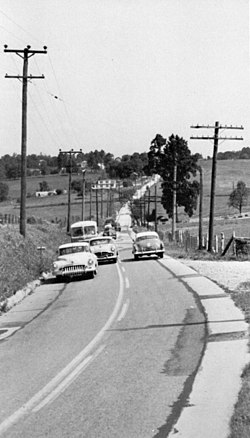
This rural road was widened but is still too narrow for 1953 traffic.
The PRA’s study, made with the help of the Board of County Consultants[N 1] and the State highway departments, did little to assuage the feelings of the extreme ruralists. The survey disclosed that of the 2.5 million miles of local roads in the United States in 1949, 323,000 miles were already on the Federal-Aid Secondary System. Another 100,000 miles carrying at least 100 vehicles per day could and should be transferred to the Federal-Aid Secondary System.[1] Another 400,000 miles was described as “wholly nonessential.” To bring the remaining 1.8 million miles up to acceptable standards and provide adequate main- tenance over a 20-year period would cost the local governments about $894 million per year. Since the local units were already spending $835 million per year on roads, the PEA concluded “It is apparent that a relatively small addition, with efficient management, applied to a planned program would be sufficient to accomplish the satisfactory improvement of local roads in a period of 20 years.”[2]
The report concluded that what local roads needed was not so much more money as improved administration. Federal cooperation and participation, the PRA thought, could best be achieved through coordination at the State level.
- ↑ In 1946 the Federal Works Administrator appointed a Board of County Consultants consisting of 10 county officials from the PRA’s 10 geographical administrative areas to advise the PRA on the secondary road program.

BPR “Driver Behavior” studies to measure speed, spacing, and lateral vehicle placement on the road, 1945.
162
